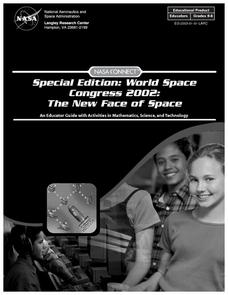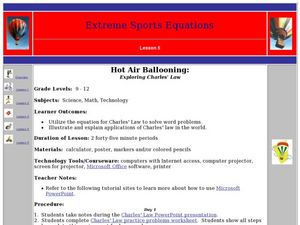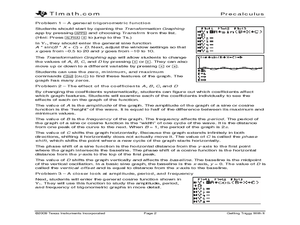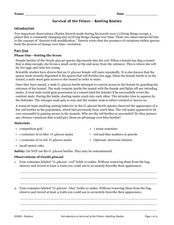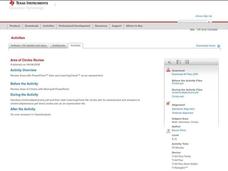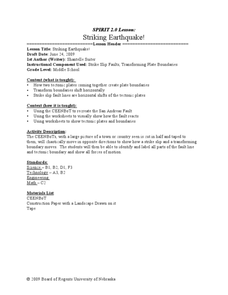Curated OER
Special Edition: World Space Congress 2002: The New Face of Space
Students experience and study how space offers expanding resources for commerce, science, technology and education. They view how advances in space can and do improve life on Earth. Each student views a geological exploration within this...
Curated OER
Hot Air Ballooning: Exploring Charles' Law
Students solve word problems dealing with Charles' Law. In this Charles' Law lesson, students observe PowerPoint presentations concerning Charles' Law. They complete a WebQuest and describe the relationship between hot air balloons and...
Curated OER
By the Pound, Gram Liter or Gallon
Students participate in experiments at five stations to practice measurement. In this measuring lesson, students are presented different produce and objects and must measure with an appropriate tool. Students use metric and customary...
Curated OER
Match Me!
Young learners explore motion graphs in this lesson. They investigate distance-time plots as they move in a specific way in front of the CBR in an attempt to make a motion plot that matches a given plot. Pupils explore the connections...
Curated OER
Getting Triggy With It
The concept of sine and cosine is explored in this lesson where students graph sine and cosine graphs using a transformation application on the graphing calculator. Students change the coefficients for the amplitude, period,...
Curated OER
Compound Interest
Pupils analyze the variables in the formula of a compound interest. They model the increase or decrease of an investment using compound interest and discuss different compounding periods.
Curated OER
Collect Data Using a Transect Line
Learners learn about transect lines through a study of marine debris. In this marine debris instructional activity, students calculate the items on a transect line and graph them. Learners complete a category worksheet.
Curated OER
Survival of the Fittest -- Battling Beetles
Students experiment with traits. In this Science lesson, students test the strength of beetles using M&M candies in lieu of the insects. Students use the Hardy-Weinberg Equation to calculate possible offspring traits of further...
Curated OER
Dolphins
Students explore sea life. In this cross curriculum fine arts, science, and P.E. "dolphins" activity, students sing songs and play games about dolphins, perform water experiments, create mosaics, and use their five senses to explore sand...
Curated OER
Oxygen vs. Air Pressure
Students perform an experiment to show that water level is affected by air pressure.
Texas Instruments
Area of Circles
Students explore circles. In this algebra/geometry instructional activity, students discover the formula for the area of a circle, as they investigate the ratio of the area of a circle to the radius^2.
Curated OER
Polymer Chemistry: More than Just Plastic
Fifth graders examine polymers and how they are formed. In this chemistry lesson plan students complete their own polymer experiment then discuss what they learned.
Curated OER
Be a Problem Solving Star
Third graders observe a math problem and discuss what it is and what they should do with it. They are introduced to the STAR steps for problem solving and discuss how to use it to answer math problems as well as incorporating some of the...
Curated OER
Math, Chemistry, and Food
Learners explore the effects of chemical reactions when cooking. Using the Internet, they research enzymes and then mix jello. They examine their results and test enzyme activity by adding pineapple to the jello. Finally, they test...
Curated OER
Basic Ideas of Functions
In this Algebra I/Algebra II worksheet, young scholars determine whether or not a relation is a function. Students determine the domain of a function and express the answer in interval notation. The three page worksheet...
Curated OER
Measure & Evaluate Range, Mean, Median, Mode
Young scholars learn mean, median, and mode through setting up a science experiment. In this measures of central tendency lesson, students drop a marble into a box with 2 inches of flour and record the data. Young scholars could also...
Discovery Education
Mood Music!
Grouchy? Sad? Here's a great resource that shows kids how music can be used to lift their spirits. Kids collect and chart data on the effects of music on emotions. After analyzing the results of their experiment, they develop...
Curated OER
The Mitten
Explore the Ukraine through a reading of The Mitten. Readers will determine the sequence of events, cause and effect, make predictions, and find the main idea of the story. They also use math skills to make charts and graphs. Finally,...
Curated OER
Electronic Circuit Design
Learners design circuits to power 3-9 volt devices such as CD players or flashlights. After measuring the voltage and current requirements for the item, they design a loaded voltage-divided circuit to power it. Students work in teams to...
Curated OER
Whitewater Canal State Historic Site
If you happen to live in Indiana, or a neighboring state, and are planning a field trip to the Whitewater Canal State Historic Site, then this lesson plan will suit your needs quite well. In it, suggestions for activities before, during,...
Curated OER
A Walk on the West Side
Students comprehend what makes up the physical community. Read and construct scale drawings and models. Explore the history of infrastructures and how the contributions of science, math and industry have led to the development of their...
Curated OER
Probability: The Study of Chance
Learners practice the basic principles of probability by conducting an experiment, determining if a game is fair, collecting data, interpreting data, displaying data, conducting analysis, and stating and applying the rule for probability.
Curated OER
Normal (dip-slip) Earthquake!
Students label the fault lines and tectonic plate boundaries on the world map. In this earth science lesson, students simulate ocean floor formation using CEENboTs. They explain the causes of earthquakes.
Curated OER
Striking Earthquake!
Students simulate strike slip faults using CEENBoTs. For this earth science lesson, students identify the fault lines and tectonic plates on a world map. They label the different parts of a fault line.
